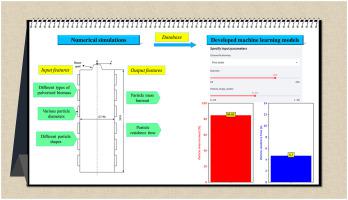Biomass & Bioenergy ( IF 5.8 ) Pub Date : 2023-05-18 , DOI: 10.1016/j.biombioe.2023.106817 Aleksandar Milićević , Srđan Belošević , Mileta Žarković , Ivan Tomanović , Nenad Crnomarković , Andrijana Stojanović , Goran Stupar , Lei Deng , Defu Che

|
When planning the development of the energy sector, significant attention is given to the energy from the renewable sources, amongst which the biomass has an important role. Computational fluid mechanics and machine learning models are the powerful and efficient tools which allow the analysis of various heat and mass transfer phenomena in energy facilities. In this study, the in-house developed CFD code and machine learning models (Random Forest, Gradient Boosting and Artificial Neural Network) for predicting the biomass trajectories, particle mass burnout and residence time in a swirl burner reactor are presented. Pulverized biomass combustion cases (fine straw, pinewood and switch grass) with various mean diameters (ranging between 60 and 650 μm) and different shape factors (within the range 0–1) are considered. The results of numerical simulations revealed a noticeably nonlinear dependence between the input values (particle types, sizes and shapes) and the output values (particle trajectories, mass burnout and residence time), mostly due to the complex swirling flow in the reactor. For particles with the mean diameters within the ranges considered, the mass burnout of particles generally decreases as the biomass particle shape factor increases. The residence time of pulverized biomass in the reactor shows in most cases a decreasing trend as the particle shape factor increases. Artificial Neural Network showed the best predictions for both particle mass burnout (RMSE = 0.083 and R2 = 0.937) and particle residence time (RMSE = 1.145 s and R2 = 0.900), providing the reliable assessment of these important indicators in the combustion process.
中文翻译:

生物质颗粒大小和形状对旋流稳定燃烧器反应器燃烧过程的影响:CFD 和机器学习方法
在规划能源部门的发展时,对可再生能源的能源给予了极大的关注,其中生物质能发挥了重要作用。计算流体力学和机器学习模型是分析能源设施中各种传热传质现象的强大而高效的工具。在这项研究中,介绍了内部开发的 CFD 代码和机器学习模型(随机森林、梯度提升和人工神经网络),用于预测旋流燃烧器反应器中的生物质轨迹、颗粒质量燃尽和停留时间。考虑了具有不同平均直径(范围在 60 和 650 μm 之间)和不同形状因子(在 0-1 范围内)的粉状生物质燃烧情况(细秸秆、松木和柳枝稷)。数值模拟的结果揭示了输入值(粒子类型、大小和形状)与输出值(粒子轨迹、质量燃尽和停留时间)之间明显的非线性依赖性,这主要是由于反应器中复杂的涡流。对于平均直径在所考虑范围内的颗粒,颗粒的质量燃尽通常随着生物质颗粒形状因子的增加而降低。粉状生物质在反应器中的停留时间在大多数情况下显示出随着颗粒形状因子的增加而减少的趋势。人工神经网络显示了对粒子质量燃尽的最佳预测(RMSE = 0.083 和 R 质量燃尽和停留时间),主要是由于反应器中复杂的涡流。对于平均直径在所考虑范围内的颗粒,颗粒的质量燃尽通常随着生物质颗粒形状因子的增加而降低。粉状生物质在反应器中的停留时间在大多数情况下显示出随着颗粒形状因子的增加而减少的趋势。人工神经网络显示了对粒子质量燃尽的最佳预测(RMSE = 0.083 和 R 质量燃尽和停留时间),主要是由于反应器中复杂的涡流。对于平均直径在所考虑范围内的颗粒,颗粒的质量燃尽通常随着生物质颗粒形状因子的增加而降低。粉状生物质在反应器中的停留时间在大多数情况下显示出随着颗粒形状因子的增加而减少的趋势。人工神经网络显示了对粒子质量燃尽的最佳预测(RMSE = 0.083 和 R2 = 0.937) 和颗粒停留时间(RMSE = 1.145 s 和 R 2 = 0.900),为燃烧过程中的这些重要指标提供了可靠的评估。









































 京公网安备 11010802027423号
京公网安备 11010802027423号